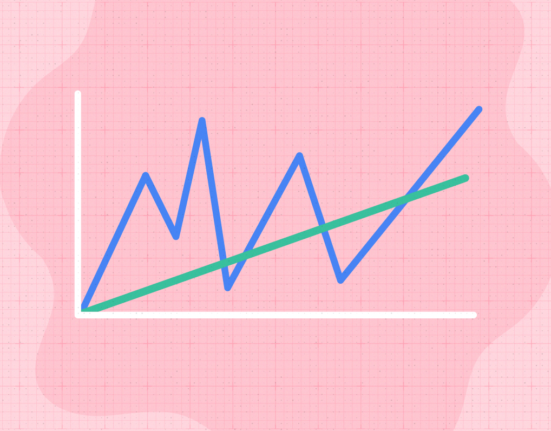Analyzing stocks can help you find some great investing opportunities. You don’t need to be an expert in analysis or dig too deep, but the more you know, the better your investing journey will be. There are two types of stock analysis:
Fundamental analysis
It is based on the assumption that a stock price doesn’t currently accurately reflect the value of the company. This can help you identify stocks that are trading at a discount – putting you in a great position to capture market-beating returns in the future. This is often used by long-term investors, who focus more on the fundamentals of the company rather than short term price movements.
Technical analysis
Technical analysis generally assumes that a stock’s price reflects all available information and that prices generally move according to trends. In other words, by analyzing a stock’s price history, you may be able to predict its future price behavior.
One important distinction is that fundamental analysis is intended to find long-term investment opportunities, whereas technical analysis typically focuses on short-term price fluctuations.
We at Thndr are advocates of long term investing. By focusing on great companies trading at fair prices, we believe investors can beat the market over time.
The two key fundamental approaches are:
- Quantitative analysis – crunch the numbers
- Qualitative analysis – look beyond the number
Quantitative analysis
All companies that are publicly traded must release all their financial information – which they release in a quarterly earnings report. These reports generally provide an update of all three financial statements, including the income statement, the balance sheet, and the cash flow statement. As part of your stock analysis, you should be looking at these statements to answer the following questions:
Is the company growing?
You can find that by looking at net income – if the number is increasing from year to year, it’s an indicator that the company is growing.
Net income = Total income – total expenses
Can the company control its costs?
The profit margin is a measure of a company’s profitability – the higher the profit margin, the more the company can control its total costs efficiently.
Profit margin = Net profit / Total revenue
How efficiently is the company using investor’s money to generate profit?
Looking at return on equity shows you how much in profit the company earns from each dollar of shareholders’ equity. A high ROE means the company can generate net profits for its shareholders. The higher the ROE relative to its competitors, the better the management of the company is at creating profits for its shareholders.
ROE = Net income / Shareholder’s equity
Is the stock overpriced, underpriced or fairly priced?
One way to figure out if you’re getting more bang for your buck is by measuring the price to earnings ratio. The P/E ratio is how much people are willing to pay for $1 of earnings. A P/E ratio of 10, means that investors are willing to pay $10 to get $1 of profit. Generally, a lower P/E ratio (below industry average) means that the stock is undervalued and might be a good opportunity to buy. However, this might also indicate that the company’s profits are declining.
P/E ratio = Share price / Earnings per share
Another way to figure out whether a company’s share price reflects its actual value is by looking at the PEG ratio. The PEG ratio is the P/E ratio divided by the company’s earnings growth rate. This is a more sophisticated metric than the standard P/E because it accounts for the company’s growth potential in the company valuation. A PEG that is less than 1 generally means that the stock is undervalued, and if it’s above 1, it’s overvalued.
PEG ratio = P/E ratio / Earnings growth rate
How much does this company depend on debt?
Debt is not always bad. If it is used to fund a high ROE project, then it may be a cheap source of funds. Yet, if the debt is a reflection of persistently negative operating cash flow, then the firm may be relying on a lifeline to remain alive and this may increase the risk of financial distress. You can assess this by looking at a company’s debt to equity ratio. Typically, a ratio that ranges from 1-2x equity is acceptable. Higher ratios – without a strong justification – should make you alert.
D/E ratio = Total debt / total shareholders equity
How much do they give out in dividends – if any?
A company that is still growing rapidly might not pay dividends because it wants to invest as much as possible into further growth. Many investors consider dividends as a source of passive income – if this matters to you, then the dividend yield is an important metric to look at. The higher the yield, the more dividend value you will gain from each share you own.
Dividend yield = Annual dividends per share / Current share price
How sensitive is the stock compared to market movement?
Not all stocks react similarly to market changes; some are more sensitive than others. The volatility of a stock is measured and called beta. Typically a lower beta means it has lower volatility and risk. However, if the risk is low, that means there is less opportunity for reward.
Qualitative analysis
When looking at a company through a qualitative lens, you want to understand the company itself, rather than just crunching numbers from financial statements. It focuses on the non-quantifiable aspects of the company, such as – the management team, how the company makes money, and relevant company/industry news.

The management team
Some believe that this is the most important criteria to consider. It makes sense – even the best business model is doomed if the leaders of the company aren’t properly executing the plan. While it’s difficult for retail investors to meet and truly evaluate managers, you can look at the company’s website and check the resumes of the managers and the board members online. How well did they perform in prior jobs? Have they been unloading a lot of their stock shares lately?
Business model
How exactly does the company make money? This might seem obvious, but it’s not as straightforward as it seems. If a company’s business model is based on selling burgers, is that actually their main revenue stream? Mcdonald’s for example, generates higher income from real estate than fast food.
Competitive advantage
A company’s long-term success highly depends on its ability to maintain a competitive advantage. Powerful competitive advantages, such as Disney’s brand name and Microsoft’s domination of the personal computers, allows a company to keep competitors at bay and enjoy growth and profits. When a company can achieve a competitive advantage, its shareholders can expect to reap rewards for decades.
Company and industry news
One of the most important things to do when analyzing a company, is following the news – for both the company and the industry as a whole. Is the company experiencing a sequence of negative news? How is it affecting the share price? Is it temporary or long-term? To keep up with the news, subscribe to Thndr Claps, for news on the US, Egyptian, and Saudi market.










